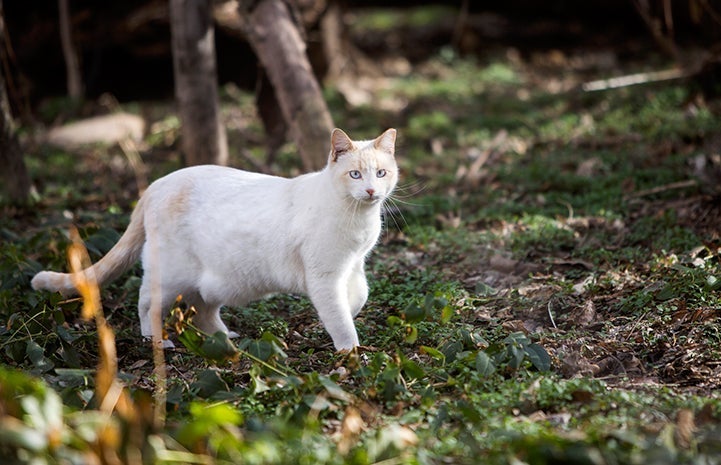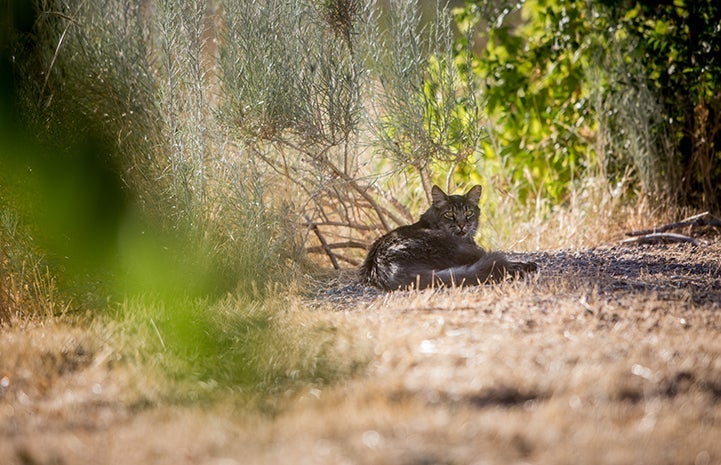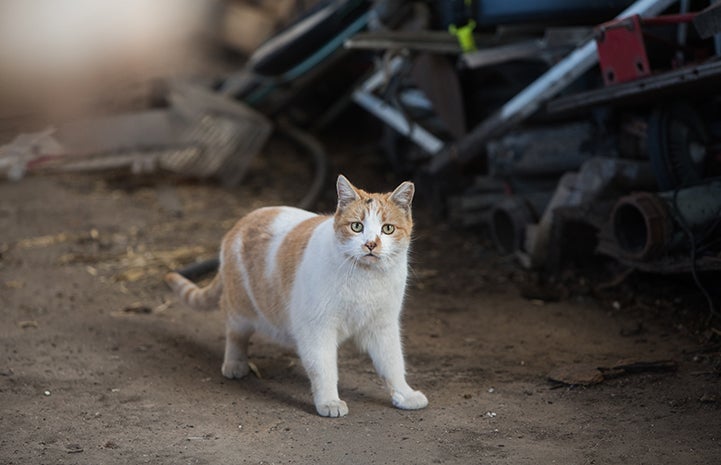
How to Use Humane Cat Traps for TNVR
The following are guidelines recommended by Best Friends Animal Society for trapping community cats (often referred to as free-roaming, stray, and feral cats) for the purpose of trap-neuter-vaccinate-return (TNVR). Specific instructions for how to trap feral cats might be slightly different depending on the type of humane cat trap that you are using.
Finding and funding humane cat traps
Humane cat traps are widely available from local animal shelters and rescue groups. In addition, these organizations might be able to provide the names and phone numbers of local nonprofit groups that can help you with trapping cats, as well as the location of low-cost spay/neuter clinics. You can also buy humane cat traps at some hardware stores and online from websites, such as Havahart and Trucatch.
Preparing to trap cats
If possible, establish a routine and get the cats used to being fed at the same place and time every day. To ensure that the cats will be hungry, don’t feed them the day or night before you are going to trap. Be sure to notify others who feed the cats not to leave food out. Hungry cats will be less apprehensive about entering the trap.
You want the cat to be in the trap a minimum amount of time before surgery, so trapping the night before is usually the best approach. Cats should not eat after midnight the night before surgery.
Prepare the area where you will be holding the cats before and after surgery. A garage or other sheltered, temperature-controlled, protected area is best. Lay down newspapers or absorbent material to catch stool, urine, and food residue.
Prepare the vehicle you will use to transport them as well. Putting down plastic is a good extra precaution, but you will need to use newspapers or some other absorbent material on top of the plastic. (Urine will roll right off the plastic, and that isn’t what you want.)
Plan your day of trapping carefully. Remember that you might have only one chance to successfully trap a cat. If you trap cats and then release them, it is unlikely that you will be able to catch them again. They learn very quickly!

If there are young kittens involved, they won't be weaned from their mother until they are 4 to 6 weeks old, and they won't be ready for surgery until they are 8 to 10 weeks old. So if you are trapping a lactating female, try to locate the kittens and see whether they are old enough to be weaned.
If you wish to foster, socialize the kittens to people, and find homes for them, they should be taken from the mother at 6 weeks old or earlier. If you wait until the kittens are older than 6 weeks, you will find that the job of socializing them gets harder the older they are.
Because kittens are at high risk in most shelters, if you are not able to foster them we recommend leaving healthy kittens with their mom until they are old enough for TNVR.
Setting the TNVR cat traps
Plan to set traps just before or at the cats’ normal feeding time. Dusk is usually the best time to set traps. Don’t trap in the rain or the heat of day without adequate protection for the cats in the traps. Cats are vulnerable in the traps and could get drenched during storms or suffer from heatstroke in the sun.

See how your community is doing
Fold sheets of newspaper or absorbent material to line the bottom of the trap and cover the trip plate. Cats don’t like walking on wire surfaces, and the lining material helps to keep their feet from going through the wire bottom when you pick up the trap. Make sure the lining material does not extend beyond the trip plate. Too much lining material can interfere with the trap mechanism or prevent the door from closing properly.
Place traps in the area where the cats usually feed or have been seen. Cats are much less likely to enter the trap if it wobbles, so make sure you place the trap on a level surface. If you’re trapping in a public area, try to put the traps in spots where they won't be noticed by passersby (who might not understand that you aren't trying to harm the cats). Bushes are often places where cats hide and provide good camouflage for the trap.
To bait the trap, spoon a small amount of tuna, mackerel, or other smelly treat onto a paper plate. Don't put any food bowls or cans with sharp edges inside the trap. Place the paper plate at the back of the trap beyond the trip plate. Drizzle some “juice” from the bait along the bottom of the trap to encourage the cat to walk in.
If the cat is eating the food without setting off the trip plate or stealing food from the trap, you can place the paper plate on the ground and press the trap down onto the food so that it squishes up through the wire bottom. The idea is to make the food a little hard to get.
After baiting the trap, open the trap door by pushing the top of the door in and pulling the bottom of the door upward. There is a small hook attached to the right side of the trap top. It hooks onto a tiny metal cylinder on the right side of the door. The hook holds the door in an open position, which also raises the trip plate. When the cat steps on the plate, it will cause the hook to release the door and close the trap.
After setting the trap, cover it with a large towel or piece of sheet. Cover the top, sides, and back of the trap; fold the material at the front end of the trap to expose the opening. The cover will help to camouflage the trap and serve to calm cats after they're caught.

Waiting nearby for cats to be trapped
Never leave traps unattended in an unprotected area because animals are vulnerable after being trapped. Plus, a passerby might release the cat or steal the trap. But don’t hang around within sight of the cats, or you will scare them off. Wait quietly in a place where you can see the traps without disturbing the cats, and be patient. Even if you’re quite a distance away, you can often hear the traps trip.
As soon as the intended cat is trapped, completely cover the trap and remove the trap from the area immediately. Keeping the cat covered will help them to stay calm. The cat might thrash some, but resist the urge to release them — and remember that you are doing this for the cat's benefit.
You might consider putting another trap in the same spot if it seems to be a popular spot. But be sure to dispose of the food left on the ground when you pick up the trap. You don’t want to litter or give out any freebies to spoil appetites.
When you get the captured cat to a quiet area away from the other traps, lift the cover and check for signs that you have the correct animal and not a pet or a previously spayed/neutered community cat (look for an ear tip).
If you note that you have captured a lactating female, check the area for kittens. And keep in mind that she must be released as soon as she is awake and alert after surgery, so she can care for and nurse her kittens. Cover the trap back up as soon as possible.
If you inadvertently catch a wild animal attracted to the food or a cat you didn’t intend to trap, simply release the animal quietly according to the release procedure below.
Holding before taking cats to the vet
After you have finished trapping, you will have to hold the cats overnight in a safe, enclosed location until you can take them to the veterinary clinic. Place the cats in the prepared protected area. Keep the cats covered and calm, and don’t feed them. They will remain quiet as long as they are covered. Do not stick your fingers in the traps, try to open the trap, or allow children or pets near the traps. Scared and confined animals might scratch and bite.
Spaying/neutering
Make arrangements in advance with a veterinarian for spaying or neutering and vaccinating the cats. Ask about the possibility of discount rates for community cats; some vets are willing to offer such reductions as a community service. Tell the vet and staff that they will be dealing with potentially feral cats, so they know what to expect. Confirm that dissolvable sutures will be used.
After spay/neuter surgery, if a cat does not seem to be recovering well, consider having the cat rechecked by a vet before release. When cats are recovering from anesthesia, they are unable to regulate their body temperature, so keep them in a temperature-controlled area and away from loud noises or other things that might be stressful for them.

Once the cat is awake, you can use a trap fork to isolate them from the door to open the door slightly to feed the cat a small amount of canned food. Canned food will provide adequate moisture for the cat, so you won't need to supply water (assuming the cat is returned on schedule).
In most cases, you will hold the cats overnight after surgery and return them the following morning. However, if you have lactating cats, you might need to return them sooner so they can go back to their kittens. Generally, returning lactating cats a few hours after they are fully awake is allowed, but always confirm with your veterinarian.
There is no need to hold female cats post-surgery longer than male cats. In fact, holding a cat longer can increase the risk of post-surgery complications and infections. Extended holding times beyond the overnight period is usually only needed for cats who had an unforeseen complication during the surgery, who had a harder time recovering from anesthesia, or who had an additional issue (e.g., eye removal or leg amputation) requiring extra monitoring.
Releasing the fixed cats
Return the neutered or spayed cat in the same place that you trapped him or her. Do not relocate the cat; it can be construed as abandonment and the cat might die. It’s common for cats to drive away new cats who appear in their area.
Make sure the spot you pick for release does not encourage the cat to run toward danger (such as a busy street) to get away from you. Keep the trap covered until you are ready to release the cat.
When you’re ready, simply hold the trap with the door facing away from you, remove the cover, and open the door. The cat will probably bolt immediately out of the trap. If that doesn’t happen, tilt the trap so the back is slightly up and tap on the back of the trap to encourage the cat to leave. Don’t ever put your hand in the trap.
Resume the feeding schedule as usual. You might not see the cat for a couple of days, as they might be a little stressed. However, they know where their food source is and will eat when you are not around.
After releasing the cats, hose off the traps and disinfect them with bleach. Never store traps in the “set” (door open) position because animals might wander into the traps (even unbaited ones) and starve to death.
